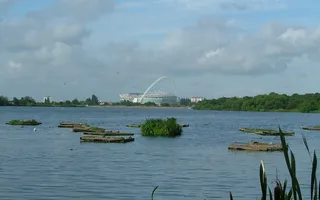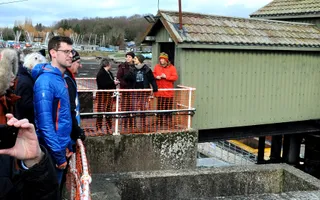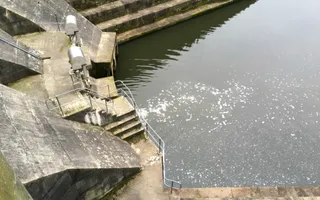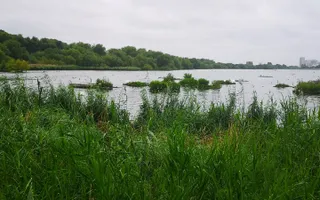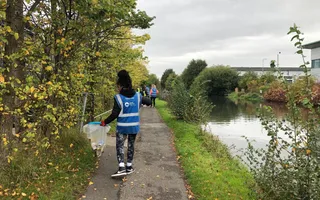Brent reservoir: What’s happening?
We're undertaking a programme of essential winter maintenance work at Brent Reservoir Site of Special Scientific Interest (SSSI), also known as the Welsh Harp.
Join us for a behind-the-scenes tour of the Brent Reservoir
What will this include?
The reservoir works, which are supported by players of People's Postcode Lottery, will include repairs to the chains and rods that operate the reservoir's sluices; and repainting the Valve House Tower from where the sluice gates which control the water levels in the reservoir are operated.
To complete the statutory works, which are required under the Reservoir Act 1975 and were identified during an inspection in 2021, the reservoir will need to be fully drained.
A fish rescue will be carried out whilst the reservoir is being drained. As well as employing our own dredging contractor to clear debris from the reservoir, we are planning to work with volunteers and our partners to clear the rubbish from the reservoir edges.
A significant urban wild space
Ros Daniels, our director for London & South East, explains: “The Welsh Harp, with Brent Reservoir at its heart, is one of London's most significant urban wild spaces.
“The Reservoir will remain open to the public throughout the works, but signs will be up warning people not to walk onto the Reservoir's drained area and mud.
“Sadly we are expecting to see a lot of rubbish again when the Reservoir is fully drained, just as we did back in January 2021, when we partially drained the reservoir to inspect the dam and Valve House.
“We’d like to take the opportunity to clear as much of the rubbish that will be revealed as possible, and we have launched a Crowd Funding campaign to help support that work”
Litter pick events
Come join us and help clear rubbish and plastic pollution around the Welsh Harp Reservoir!
- Let's Volunteer! - Welsh Harp - Dewatering Edition - Sunday 18 February
- Let's Volunteer! - Welsh Harp - Dewatering Edition - Saturday 24 February
Project update: 16 April 2024
We’ve now successfully completed a range of critical works at the reservoir. These works include the replacement of the pulley wheels, brackets and chains to both sluice gates which will allow the gates to be safely operated in the future. We were also able to inspect the dam structure and undertake a range of minor concrete repairs. The painting works to the Valve Tower to protect the metal structure from future corrosion, is progressing very well. We’ve completed the painting between the -5.5m and -2.0m (below weir crest) levels. We’ll be painting the remaining upper section from a floating pontoon to allow the works to continue as the reservoir refills.
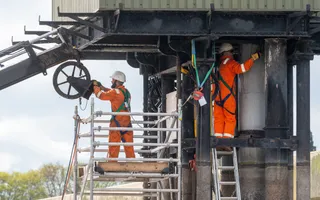
We’d confirm all gabion baskets deployed within the reservoir as part of the upstream silt mitigation measures have now been recovered. And we started the reservoir re-fill process on Saturday 13 April. The reservoir will now be re-filled in a controlled manner, by a maximum of 500mm per day to avoid any disturbance to nesting birds.
The perimeter of the reservoir is being inspected for nesting birds every 48 hours. If a nest is discovered, then re-filling of the reservoir will be stopped so that the situation can be reviewed, working with Natural England if necessary.
There are still risks associated with this project, which are being carefully managed, and the refill rate is very much dependent on the weather and inflows to the reservoir. Therefore, we can’t at this stage give a definite date for when the reservoir will be fully re-filled to its normal operating level. However, we’re currently estimating that the reservoir will be re-filled by the end of May, as long as we don’t experience any prolonged dry weather periods.
Project update: 27 February 2024
Brent Reservoir Statutory Works Stakeholder Update
The Trust is required to undertake statutory works in the interest of safety at Brent Reservoir by the end of September. This work requires draining the reservoir entirely to undertake critical inspections and resilience works to the valves and the tower below the normal waterline from which they are operated.
The programme for this work was already demanding and the severe impact of the succession of winter storms have caused significant delay. The reservoir can only be drawn down gradually, under careful monitoring, because the Environment Agency is concerned at the possible release of silt into the River Brent below the reservoir. To fully drain the reservoir we’ve also needed to relocate a large number of fish.
We are acutely aware of the potential impact of this work on the SSSI, particularly the eastern end of the reservoir. We have been working closely with Natural England to develop a mitigation plan that will enable us to complete the statutory works, whilst minimising the impact on the SSSI. Natural England has accepted our plan and agreed a revised timeline that will see us complete the works and gradually begin to refill the reservoir from mid-April at the latest.
The assent from Natural England to extend the work programme includes the following series of measures to mitigate the impact of the delay on wildlife:
- Proactive disturbance measures – visual scarers will be used to discourage birds from nesting in key areas, such as marginal habitat and areas of newly exposed shingle, that fall within the refill zone. These measures include holographic tape and decoy birds of prey;
- Regular monitoring – immediately prior to and throughout the gradual refill, experienced ecologists will survey the reservoir every 48 hours to identify any nesting birds present.
- Gradual and controlled refill – a gradual and controlled refill will be undertaken to manage the reservoir level, which will be dependent upon the findings of enhanced bird nest monitoring;
- Nest relocation – should a nest be found during the monitoring surveys, the refill will be stopped with the reservoir level temporarily maintained whilst a suitable solution is developed and agreed with Natural England.
- Fish restocking – a small fish restock will be completed in the spring should the environmental conditions allow, followed by a larger restock in the winter. Only native fish species will be returned to the reservoir to create a more natural fish stock in the SSSI;
- SSSI enhancements – alongside debris removal from the reservoir, willow coppicing works and the creation of alcoves within the reedbed on the East Marsh of the reservoir that have already taken place, the Trust will be installing 13 common tern rafts to replace the existing ones in poor condition; and
- Looking to the future - surveys and funding bids are currently underway to determine works to restore the North Marsh wetlands from the 1980’s. Further pond/channel clearance involving local conservation groups is also being considered. These works are all subject to future approval from the Environment Agency and Natural England.
We appreciate the delay is disappointing for everyone who values the reservoir, its rich natural habitats, and its support for sailing and watersports. However, please be assured we are doing all we can to complete the works as soon as possible whilst acting carefully to minimise the impact on the SSSI as far as possible and secure the future of this reservoir for all users.
For any enquries about the project, please go to our contact us page.
Project update: 1 February 2024
Brent Reservoir winter works stakeholder update
We’re close to completing our fish rescue and draining of the Welsh Harp Brent Reservoir, as part of our statutory maintenance works. The weather, including persistent storms, flooding, and the cold snap immediately following Storm Isha, has impacted our progress. We have a number of tasks to complete before we can let the reservoir refill naturally, but we’re working as quickly as the weather and safe working conditions allow.
Here’s a list of the tasks to be completed over the next two months or so, weather permitting:
- Complete the fish rescue and draining;
- Clear silt from the front of the sluices and around the Valve Tower;
- Erect scaffolding around the Valve Tower;
- Carry out cleaning and preparatory brush work to the Valve Tower;
- Re-paint the Valve Tower;
- Carry out the mechanical works to the sluices, rods and chains;
- Remove the Valve House scaffolding; and then
- Allow enough water into the reservoir to enable the removal of equipment, including gabion baskets and concrete blocks.
Impact on nesting birds
We share the concerns of local conservation groups who care about the SSSI and its designated species, including wetland breeding birds and we’ve been working closely with relevant agencies to protect all the different aspects of the natural environment as much as possible throughout the project. We are currently in discussions with Natural England to agree the best way forward to secure formal permission for the works beyond the current assent date of 29 February 2024. During a gradual, managed refill, after the works are completed, we will include sensitive and proportionate mitigation measures to discourage birds from nesting on the reservoir margins until it has refilled.
Fish rescue and re-stock
Fish are an important part of the reservoir’s ecosystem, with many of the water birds, including great crested grebes, little egrets, cormorants and common terns, relying on them as a source of food. Our fish rescue has taken longer than expected, because of the number of fish we have found. We estimate that we’ll have rescued over 16,000lbs (8 tonnes) of fish, some of the very largest carp weighing in the region of 30lbs. In 2002, when we last drained the reservoir, we rescued 10,000lbs. Our dedicated fisheries contractor has indicated that the fish are healthy, and they are being re-homed across our waterways. We’ve also removed invasive species of fish.

We’ll restock the reservoir with suitable native fish, including roach and perch, in discussion with Natural England. The reservoir will be re-stocked in two phases: in the spring when the reservoir has refilled, we’ll bring in fish to support breeding birds over the summer. We will then do a full re-stock next winter. Some small fish will have remained in the reservoir in the pools of water at the margins and others will enter through the River Brent and Silk Stream feeding the reservoir.
Rubbish removal
Thanks to the support of hundreds of volunteers, Crowdfunder supporters, and local groups including Action for Silk Stream, Friends of Welsh Harp and Phoenix Canoe Club, as well as the work of our contractors Rothens, we’ve so far removed over 400 bags of plastics and other rubbish from the reservoir, as well as larger items such as e-bikes, safes, suitcases and tyres. This is important for reducing the amount of pollution caused by micro plastics and other toxins. We’ll be sending our contractors out again to remove more of the very difficult to reach debris.
Our crowd funding campaign is continuing to raise funds to support this effort:
Vegetation management
We’ve completed a series of environmental improvements at the Brent Reservoir SSSI, including creating alcoves in the reed beds last September to increase the water’s edge marginal habitat that water birds use to nest and shelter. This week we started a five-week programme of tree works, including coppicing willow trees and removing large boughs that have fallen across the River Brent. The trees are encroaching into the reed beds, shading the habitat needed by wetland birds for foraging and nesting.
Tern rafts
With the support of the Welsh Harp Conservation Group, we plan to install 14 new tern rafts, and to re-shingle as many of the existing rafts as possible. We’ve removed rafts that are beyond repair. This work will begin when the reservoir has refilled.
Common terns (Sterna hirundo) are one of the species of water bird that live on the reservoir. They are silvery grey and white birds with long tails, nick-named the ‘sea-swallow’. They are on the UK conservation Amber list, and their numbers have been significantly declining in recent years. The rafts provide useful island habitats for the terns in areas of deep or fluctuating water levels. They can improve breeding success by providing areas safe from flooding and predators. The rafts have a layer of shingle to imitate the tern’s natural nesting habitat.
For more information about the project call the Canal & River Trust on 03030 404040 or visit our contact us page.
A joint vision
Also known as The Welsh Harp, Brent Reservoir was built in 1835 to supply water to the Grand Union Canal. Today, surrounded by buildings and fast roads, it provides valuable green open space for people and wildlife.
Made up of representatives from us, the Greater London Authority, London boroughs of Brent and Barnet, London Wildlife Trust, Thames21, the Welsh Harp Strategy Group was formed in 2019 to work together to create a Joint Vision for the future of the site as a place for wildlife and people. The group published its Joint Vision for the Welsh Harp Brent Reservoir in July 2023.
Find out more
Last Edited: 3 December 2025


Stay connected
Sign up to our newsletter and discover how we protect canals and help nature thrive



